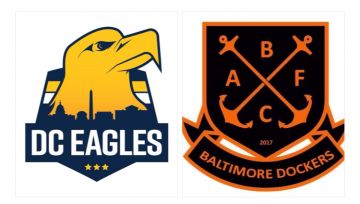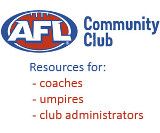Baltimore Dockers and DC Eagles Join USAFL Fold
|
|
After twenty seasons of jointly serving the Baltimore and Washington, DC metropolitan areas, the Baltimore-Washington Eagles voted last week to officially expand as two USAFL clubs, the Baltimore Dockers and DC Eagles. The new clubs will begin league play in season 2018.
The vote finalizes a move that had been long discussed by the original Eagles club, and had been punctuated by the biggest growth on and off the field in nearly a decade. The men had played their metro season this past year as the Dockers and Eagles and came together to put arguably their best season, fielding two teams at Nationals for the first time since 2012. In addition, the Lady Eagles had their biggest turnout in the history of the program, taking 14 players to Nationals.
Both clubs will be holding their AGMs in the coming weeks to name their leadership groups, but for now, Antoun Issa is leading the DC contingent while Ian Payne is at the helm for Baltimore.
“The expansion is a reflection of the growth the club has enjoyed, and the desire to capitalize on that and grow even further,” Issa said. “We want to recruit more, both men and women, and by having two clubs that focus directly on their immediate communities, we increase the chance for greater recruitment and game development.”
In Baltimore, which will have Payne and big man Ben Crenca as its base, the Dockers are optimistic at getting off to a hot start in 2018.
“With such strong player numbers, we are very excited that we can expand footy to now have two USAFL clubs in the DC/MD area,” said Payne, a native of Queensland. “It’s an exciting time for the playing group of the Baltimore Dockers and we cannot wait until next season starts.”
The creation of the two new clubs concludes the Baltimore-Washington club era, the seeds of which were sown in 1997. That year, a challenge was made to the Australian Embassy to put together a side to play an all-comers team from the Midwestern US. That “Embassy of Australia Legends,” as they became known, gained momentum over the following months, and with 19 players in toe and an agreement with the AFL’s West Coast Eagles in hand, the newly christened Washington Eagles played their first ever game on March 28, 1998, a 114-30 loss to the Boston Demons.
1999 saw another challenge laid down, this one between the Embassy (Eagles) and the Boomerang Pub, an establishment in Baltimore run by Australian ex-pats. On May 15, the Eagles scored a 72-55 victory over the pub club, known at the Baltimore Bombers. The two groups would combine under the name Baltimore-Washington Eagles, and after forming a board and constitution, joined the USAFL. Despite losing their only two regular season games, the Eagles would bounce back, teaming with the now-defunct Lehigh Valley Crocs to compete in the inaugural Division 2 competition at the National Championships in Cincinnati. The Eagles won all three group matches, then finished the year in storybook fashion with a 22-10 win over the Southern Crusaders combined side.
In spite of lean years from 2000-2005, when the club’s feel was more of a social club than that of a competitive entity on the pitch, the Eagles had a number of highlights. In 2001, the Eagles hosted the fifth edition of Nationals, held at Rosecroft Raceway in Oxon Hill, Maryland, against the backdrop of the aftermath of 9/11. Jay Hunter (USA) and Rob Brunton (Canada) would represent their countries at the inaugural AFL International Cup in 2002, while Eagles player-coach Denis Ryan would lead Hunter and the Revos to a fifth place finish in Melbourne. Michael Waller took home the Roos Medal for Division 2 best-and-fairest in 2003, despite a 1-2 showing in Kansas City.
The Grass roots efforts of people like Brunton, Ryan, Matt Bishop, Dave Schall, and countless others kept the club going, as did the establishment of a three-team metro league featuring sides representing DC, Baltimore, and Northern Virginia. The Eagles also established the Lady Eagles, who competed with the Fusion team at the first ever women’s division, contested at the 2005 Nationals in Milwaukee.
Shifting the focus to success on the pitch, fortunes of the club turned around in 2006, when a deluge of young talent joined the team. After a competitive season in the new five-team Eastern AFL, Baltimore-Washington went to Las Vegas and ran through their Division Two field, turning aside Calgary, Seattle, Dallas, and Minnesota en route to their second D2 flag. With exciting young players like Jay Levesque and RJ Wheelock in the fold, the Eagles would establish themselves as one of the premier teams in the USAFL. They would take home its first EAFL title in 2008, then make the Division 1 Grand Final in that year’s Nationals in Colorado Springs, with upstart Vancouver keeping them from taking home the chocolates.
The Eagles had reached their peak, ceding control over the region to rivals New York from 2009. A return to the Grand Final wasn’t in the cards, and despite remaining competitive on the regional stage, the transient nature of the Baltimore-Washington metropolitan market made it hard to retain players from-year-to-year. The team dropped down the ladder over the next several years, going down to Division Two in 2012, then down to Division Four in 2015. The Lady Eagles continued their growth, however, as they teamed up with the Boston Lady Demons to make it to the Women’s Grand Final in 2012, falling to Denver.
The ebb and flow of success returned to BWE in 2016, when Issa took over as president. The arrival of AFL Queensland’s Dean Vigus and former Collingwood and Melbourne player Dannie Seow helped spark recruitment, and the Eagles became competitive again. They ran off a string of wins during the season, including winning the D2 Eastern Regional tournament, and a promotion to Division 2 at Nationals in Sarasota. They knocked off fancied Sacramento in their opening game and finished 1-2.
This year saw more growth both on the field and off of it, as the Eagles seniors’ side finished 8-2 during the regular season, including big wins over rivals New York and Philadelphia. They lifted the Division 1 trophy at Eastern Regionals and ascended back to D1 at Nationals for the first time since 2011. Despite going 0-3 in Division 1 San Diego this October, their 2-1 result in the Reserves division and their play at the top level was a statement that they were back to the big time. The Lady Eagles large contingent, led by USA Freedom player Emily Riehl, combined with Boston to play well despite finishing 1-3 and fourth place in the five-team Division 2 women’s competition.
|
|
|






